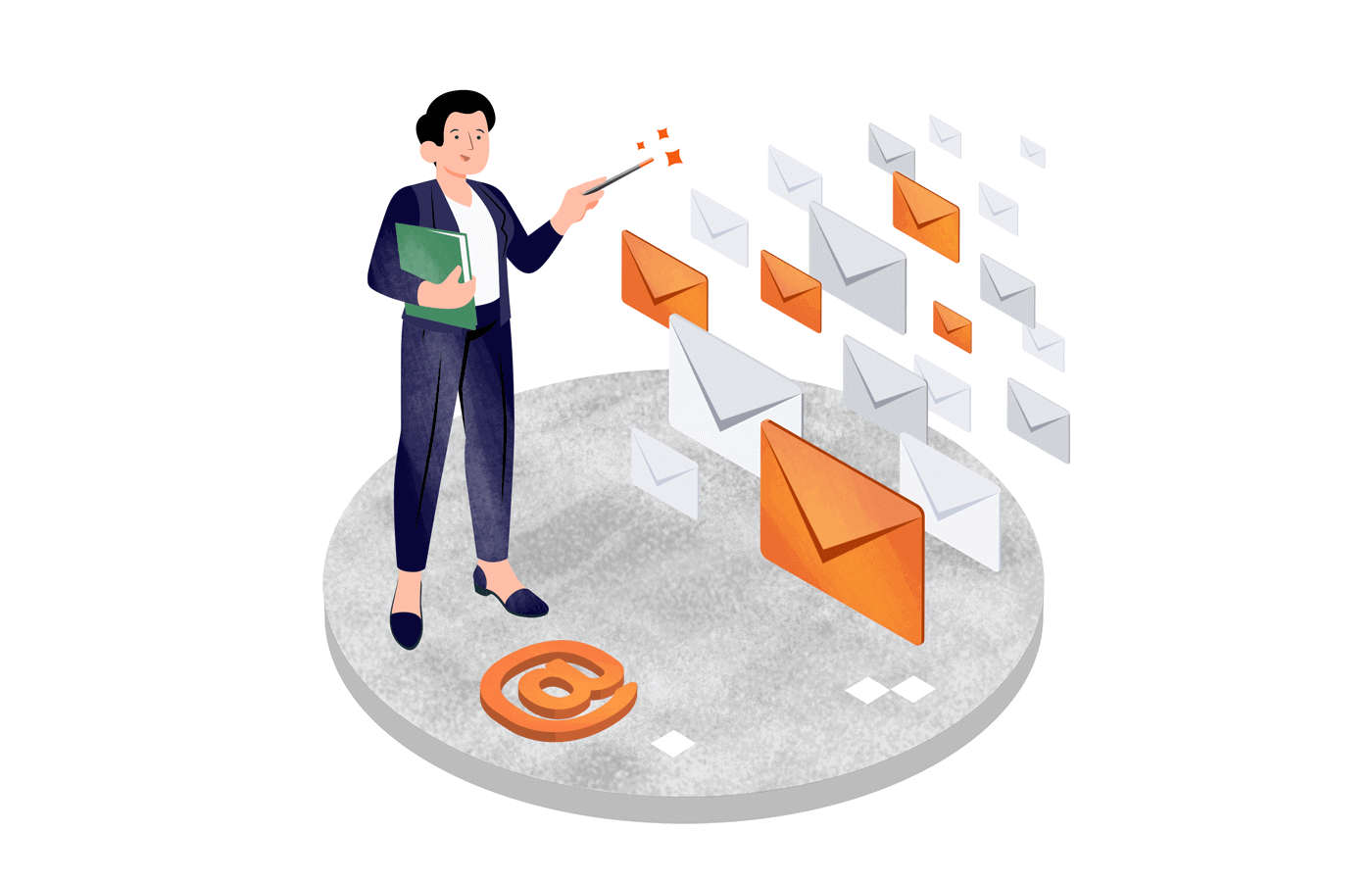You have something big to share with your audience – a big product launch, massive discounts, or a giveaway. You want to let everyone know about it but don’t have massive resources or time. Email broadcasts are the way to go.
Launching an email broadcast is like a megaphone announcement in a busy town square. It’s direct, broad, and designed to reach as many ears as possible. With a clear and compelling message, you turn the heads of your audience, sparking interest and action across your entire subscriber list. In this blog, we will share more about email broadcasts and also share some interesting examples.
What is an Email Broadcast?
According to Search Engine Journal, 90% of customers will share their email addresses for incentives. So, why not build your email list and send them email broadcasts?
An email broadcast is a powerful tool that sends the same message to your entire email list. It’s like ringing the town bell, where one call gathers the community. You keep everyone in the loop, irrespective of their preferences or other attributes.
Broadcasts are useful for business owners stepping into email marketing. It sends your news, updates, or promotions to all your subscribers simultaneously, basically a way to share big moments or offers quickly and efficiently.
- Sent to all subscribers at once: Everyone gets the same message;
- Saves time. Craft one email for your entire list;
- Builds consistency. Keep your message uniform across your audience.
- Wide reach. Ensures everyone stays up to date and no one misses out on your big news.
When done right, these emails keep your customers in the loop about your company’s products, services, or updates they care about. In return, this helps raise your brand’s awareness and create a circle of continuous customer engagement.
Difference between Email Broadcast & Email Marketing
An email broadcast campaign and personalized emails are both parts of a successful email campaign strategy. So, what’s the difference?
Email broadcasts are one-time messages designed for quick communication, while email marketing campaigns are strategic messages designed with a long-term goal.
Email broadcasts are sent as bulk emails to a large email list. It works best for quick updates on relevant information, promotions, or news to subscribers. Usually, the broadcast messaging is time-sensitive, i.e., about limited-time offers, event invitations, or breaking news. These types of emails aren’t highly targeted and have a broad reach.
On the other hand, an email marketing campaign is a more comprehensive and strategic approach to email marketing. They’re usually planned, personalized, and sent over time to segmented audiences with particular goals. They’re designed to nurture leads, build relationships with subscribers, and guide them through the sales funnel.
Unlike broadcast emails, email marketing campaigns are personalized based on customers’ behavior, interests, demographics, etc. This means recipients usually get emails tailored to them and are encouraged to take a specific action.
| Email Broadcast | Email Marketing | |
| Purpose | Designed for quick, one-time communication. | Aimed at strategic, long-term engagement. |
| Frequency | Sent as a single message. | Consists of multiple, scheduled messages. |
| Targeting | Broad reach, not highly targeted. | Highly targeted, based on customer data. |
| Content | Often time-sensitive, like news or offers. | Tailored to nurture leads and build relationships. |
| Goal | To inform or update all subscribers at once. | To guide subscribers through the sales funnel. |
Are you looking for email broadcast software? Sender’s advanced omnichannel marketing tool empowers you to create email broadcasts quickly and saves you from the hassle of sending an email broadcast manually by sending them on autopilot.
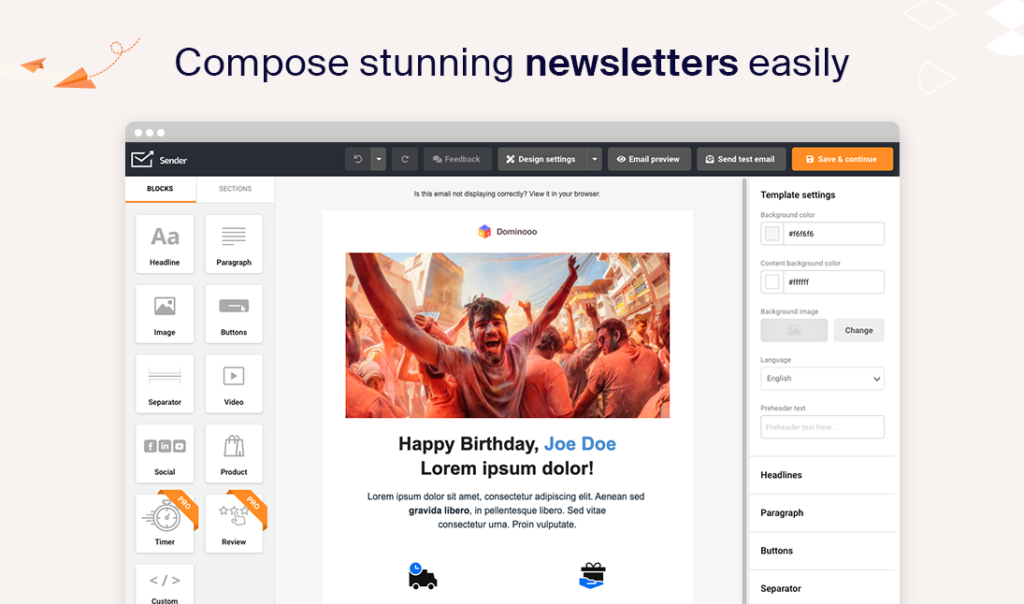
Stop manually sending email broadcasts — join the Free Forever Plan today and benefit from the automated conversation workflows with Sender’s robust features.
Types of Broadcast Emails
It doesn’t matter if you’re a business-to-business (B2B) or a business-to-consumer (B2C) company – primarily, there are four ways to use broadcast emailing for your business:
1. Newsletters
We could bet you’ve received one type of broadcast email in your inbox today – the old, trusty newsletter. Its goal is to update interested subscribers with relevant brand news regularly (weekly, biweekly, or monthly).
It’s no surprise newsletters are so popular – they help keep the brand on the top of subscribers’ minds. When done right, they’re also eagerly expected.
Newsletters are also versatile, falling under 10 possible content types (often depending on the industry):
- Business newsletters;
- Educational newsletters;
- Nonprofit newsletters;
- Industry newsletters;
- Community newsletters;
- E-commerce newsletters;
- Health and wellness newsletters;
- Travel newsletters;
- Personal newsletters;
- Curated content newsletters.
2. Important Updates
What idea should your subscribers take from your broadcast emails? No, it’s not that your brand exists. But that it’s up and running. So, if you have any significant news, it’s your chance to be loud (and occasionally proud) about it. Here’s what we mean by ’important updates’:
- Product launch announcement. Sometimes, as crucial as the new product itself, announcements create excitement and help boost engagement and sales;
- Pricing update. If the prices are reduced, you don’t need more suggestions on what to do. If the costs are increased? Well, you better tell your customers in a controlled manner before they find out themselves.
- Change to terms of service or privacy policy. There’s no more effective way to lose your customer’s trust than to change your terms or policies without them knowing. If you have considerable updates coming up, you better start crafting a broadcast email.
3. Digests
The digest email is the least brand-centric of the bunch. Though it’s still compiled by you and sent out with your brand name, it usually includes information from resources other than your company.
Digest emails help establish yourself as a niche-specific influencer, showing that you can research relevant topics and ‘digest’ them into one valuable email regularly.
Here’s what kind of bits of other content might build your digest email:
- News articles;
- Quotes from industry professionals;
- Videos;
- Images;
- Reviews, etc.
Everything goes as long as the content and topic are cohesive and relevant.
4. Sales and Promotions
Wait, what – broadcast emails can also contain sales and promotions? Yes, but no.
If you have an “everything is on sale” type of promotion, mass messaging to all your customers is a great way to spread the word and drive sales. This could also be free shipping, flash sales, and others.
Yet, if the promotion is about a specific group of products (womenswear only, for summer shoes, special senior discount, etc.), segmentation and personalization of emails are your closest chance at luck.
Another thing to consider before deciding to blast out those broadcast emails is the campaign’s ROI (Return on Investment) if it fits your brand’s image, and how it will affect your customers.
How to Send a Broadcast Email?
Sending a broadcast email can be a smooth and efficient process, when you plan it upfront. Here’s how you can send a broadcast email in four simple steps:
- Pick an email broadcast software. Choosing the right software is crucial for a successful email broadcast. Look for a tool that’s user-friendly and offers the features you need. Sender is a great option, providing an intuitive platform that makes sending broadcast emails a breeze;
- Compose email content. Craft your message with your audience in mind. Keep it clear, concise, and engaging. Whether you’re sharing news, promotions, or updates, ensure your content resonates with your subscribers. With Sender’s drag-and-drop editor, you can easily design responsive emails that capture your audience’s attention;
- Select recipients. Decide who will receive your broadcast. While you might be sending this email to a large list, ensuring it’s still relevant to those who receive it is important. Sender allows you to manage your subscriber lists efficiently, helping you choose the right recipients for each broadcast;
- Schedule the delivery. Timing can significantly impact the effectiveness of your email broadcast. Choose the best time to send your email, considering your audience’s habits and time zones. Sender’s scheduling feature enables you to plan your broadcast’s delivery at the optimal moment, increasing the likelihood of engagement.
7 Email Broadcast Examples
Are broadcast emails already on your radar? Great! You should think of sending them soon. Here are some email broadcast examples to inspire you to schedule your first broadcast:
1. Refinery29 – Newsletter
Refinery29 sends a well-curated newsletter called “Today on R29”. It contains the top picks from the brand and is sent out daily:
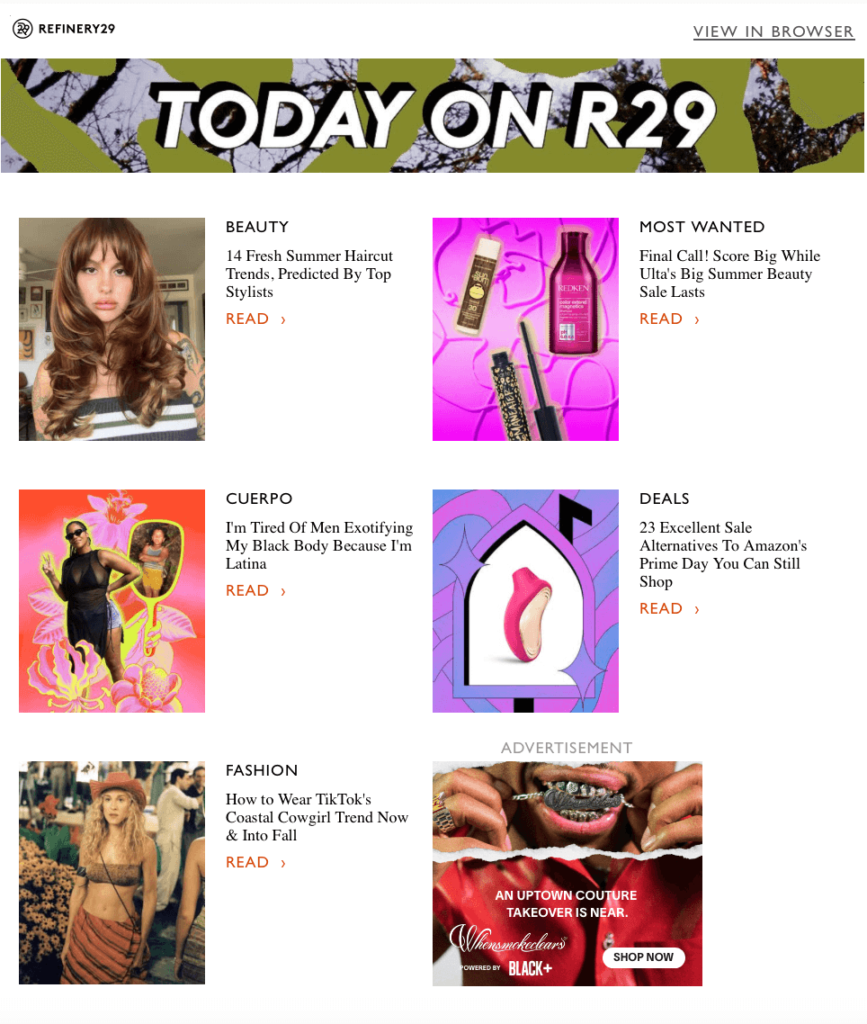
The newsletter format works great for brands that run blogs. If you have one, use broadcast email to attract subscribers and encourage them to read newsworthy pieces. Ensure the newsletters are sent out regularly to keep your readers updated and engaged. Occasionally, you may also include some company news (e.g., a new product launch, partnership, job openings, etc.)
What we like:
- The newsletter is highly visual, illustrating each topic with a captivating yet informative image;
- A strict, two-column layout helps the readability;
- Each topic falls under a specific theme (e.g., fashion or beauty), further increasing readability;
- The advertisement from partners is highlighted as such.
2. Hover – Important Update
You might remember hearing the huge fuss around GDPR (General Data Protection Regulation). All the companies registered in the EU had to update their data protection policies.
Well, some did a better job than others in informing their subscribers about it. For example, Hover, a domain service provider:
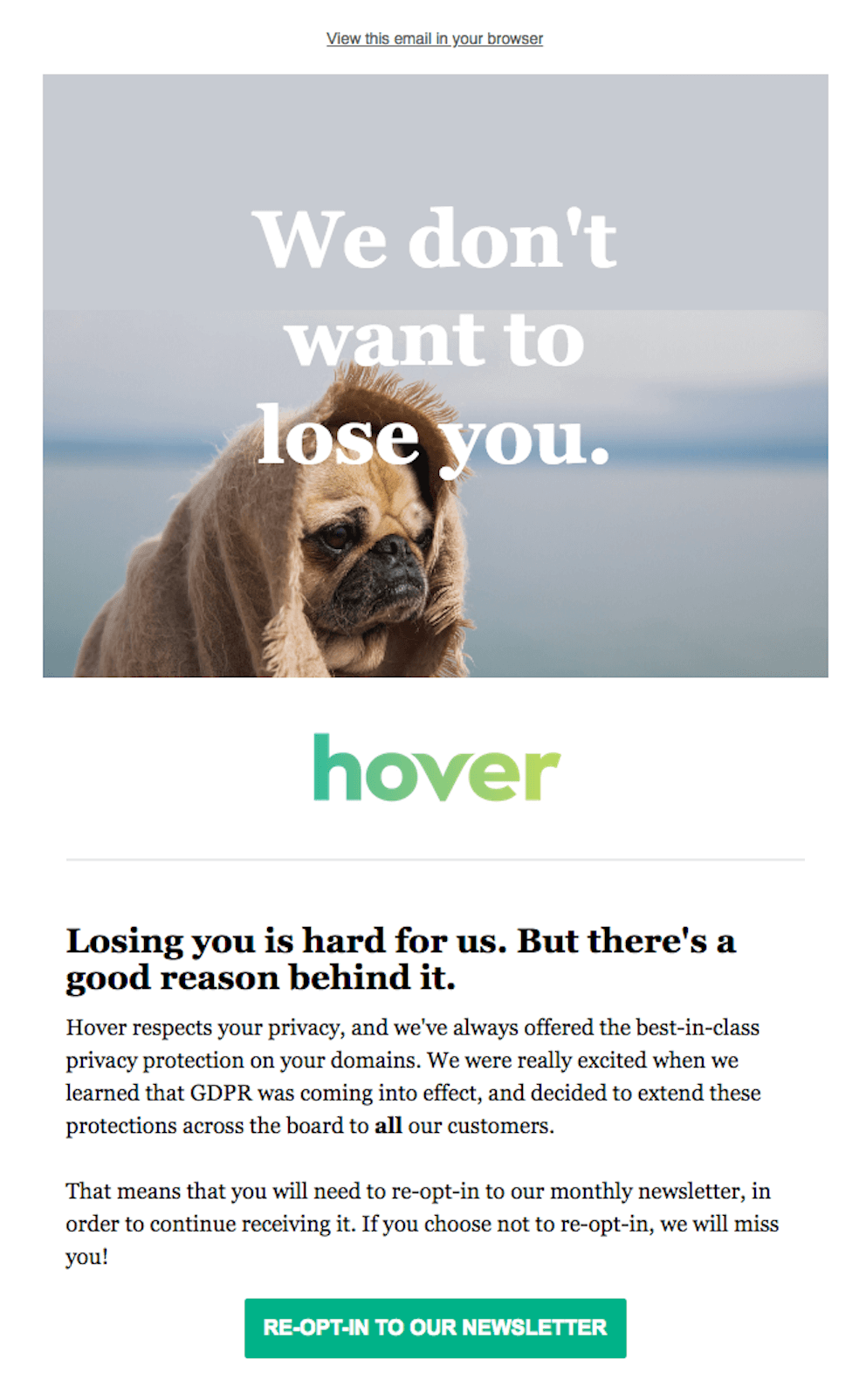
Let’s be honest – most ToS (Terms of Service) and privacy policy updates aren’t really ‘interesting.’ So how do you convince your subscribers to notice your broadcast email and also read it?
Use the success formula from Hover’s example above – humor. While it doesn’t leave readers rolling on the ground laughing, it grabs their attention and shares the update about GDPR effectively.
What we like:
- Conversational and human tone;
- Use of a humorous image and header copy;
- The text explains well why the readers should re-subscribe.
3. Pocket – Digest
Pocket App found the perfect medium for promoting their service – a digest broadcast email. Each day the brand’s team collects the best articles from around the internet and puts them into one curated email.
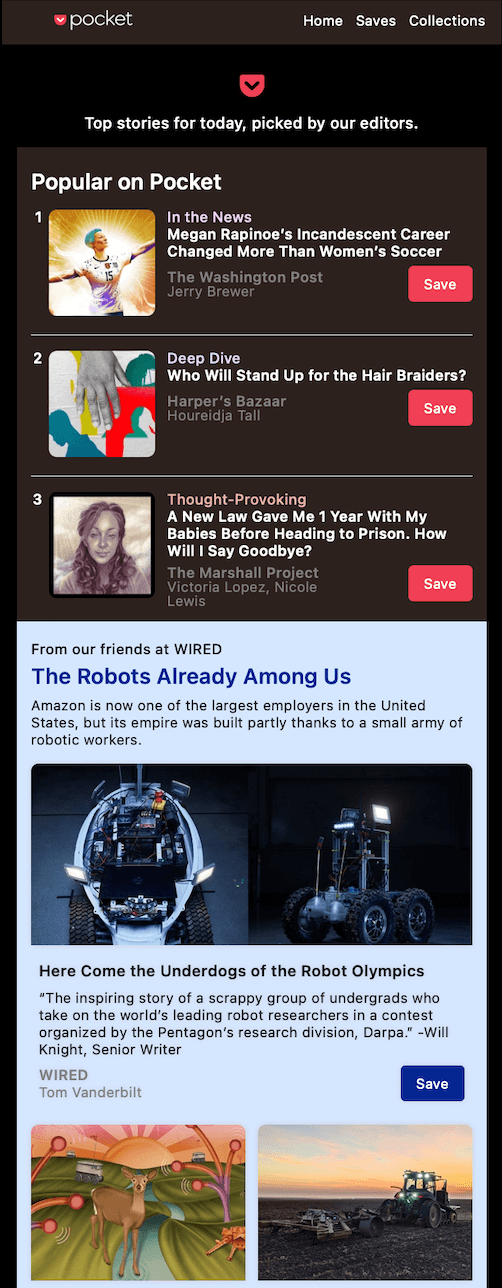
Pocket uses a personalized approach to such broadcasts. After creating an account, the news customers receive an email autoresponder asking them to choose the most exciting topics.
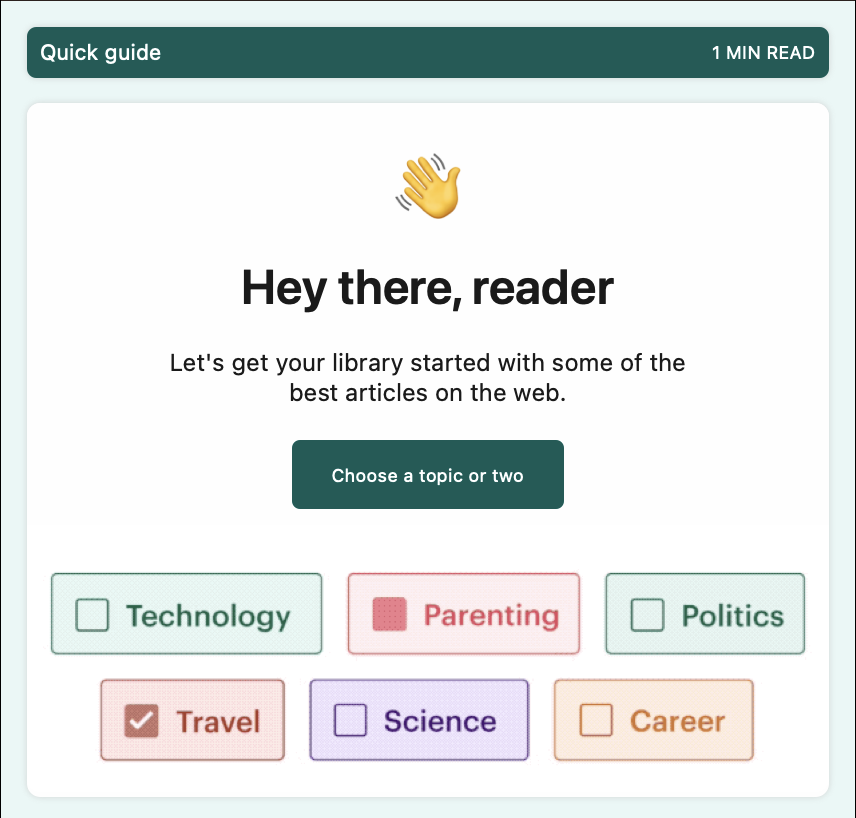
Based on their preferences, they get a curated newsletter daily. This, in return, makes the digest ever so awaited.
If you decide to go this way, remember that people preference’s change. So, allow your subscribers to update their preferences regularly.
What we like:
- Simple layout giving the recipient only the essential details about the article;
- Separate CTA (Call-to-Action) for each article, enticing users to click;
- Sponsored content has a different theme from organic content.
4. True Grit Texture Supply – Product Launch
Nobody spends time, money, and efforts in building a new product line to hear crickets on launch. Product launches are a big deal and a good way to grab attention is to send an email broadcast to your subscribers.

If you’re working with brands like Apple or Nike where customers just wait for the launch, it’s easy to just say – take it. But if your brand is relatively new, you must add awareness content (maybe a video link) and product info, like the email above. Your broadcast email should explain the idea behind the new product, how it works, and also share how to get hands on the product.
What we like:
- Clear header image and simple headline;
- Visually illustrated product features, right on tip;
- Retro email design makes the email feel different and grabs attention.
5. Casper – Exclusive Sale
A sitewide sale on a special day is a great way to entice subscribers to buy from you. Announcing the sale through an email broadcast works well for many industries. For example, have a look at this email broadcast by Casper:
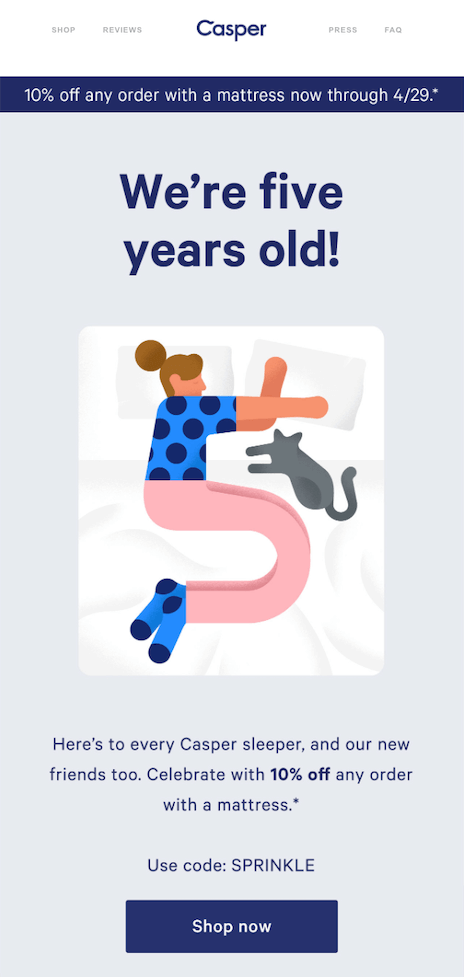
This email was sent on the fifth anniversary of Casper, gifting subscribers an extra 10% off to celebrate the occasion. The illustration is lovely and the discount code is also different than generic ‘coupon codes’. You can also think about announcing an exclusive sale using broadcast emails. Just remember, a short email is always better.
What we like:
- Using an event (company’s anniversary) as a reason to broadcast;
- Friendly and warm tone for the email copy;
- Minimal and illustrative email design.
6. Rael – Promotional Email
Broadcast emails are useful to tell your audience about limited-time promotions and offers. Companies use such promotional emails all the time to announce new offers, or even extend existing offers. Here’s an example by Rael:
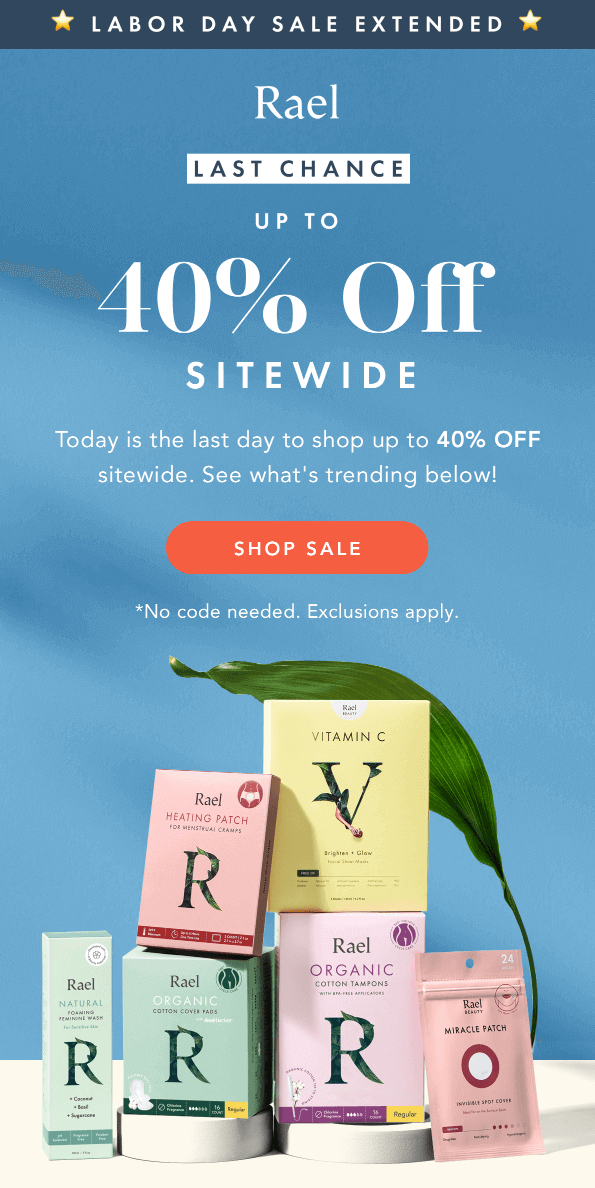
The email announces an extension for their Labor Day sale and asks readers to grab the last chance to get extra discount. There’s an element of urgency in the header, which will compel many to check out the products (and offers). Adding different sections for trending products is a great way to cross-sell products.
What we like:
- Use of words like ‘Last Chance’ to create a sense of urgency;
- Visual showcasing products on sale;
- Prominent placement of discount on the header.
7. Orangewood – Sales Email
Sales emails are sent before important sales events like Black Friday, Cyber Monday, and even when brands plan unique sale events. Here’s how Orangewood announced Black Friday Sale through an email broadcast:
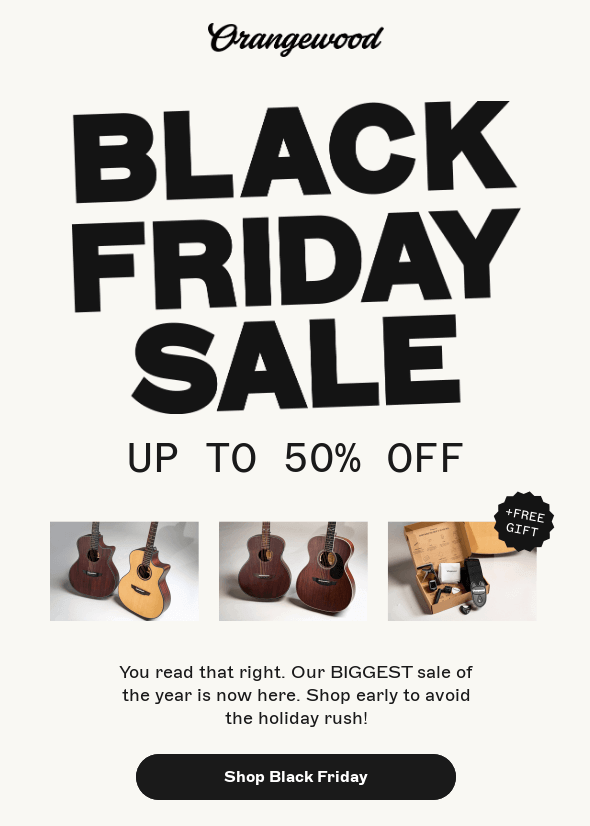
The short email is simple but manages to communicate the message. Subscribers can enjoy up to 50% discount and there’s a special gift for everyone who buys during this time. The mention about how ‘shopping early’ will help them avoid the rush (and grab the discount while they still last) is a tactic to create a sense of urgency.
What we like:
- Minimal and uncluttered design;
- Use of product images in the email;
- Design blob announcing a free gift catching instant attention.
Improving Email Broadcasting Open Rate Overtime
Including only on-point information relevant to your target audience is the surest way to get your broadcast emails noticed. Yet, there are more things you can do to make those open rates rise without looking down. Here are four of them:
Audience Segmentation
Your customers come with unique personalities, preferences, and specific needs. So, it’s unlikely that one size fits all will work for broadcast emails. You need segmentation to identify separate, unique subscriber bases and tailor your messaging accordingly.
Customer segmentation divides a large group of people into smaller groups based on specific characteristics or interests. It involves grouping individuals with similar beliefs, interests, or something else into a segment.
Segmentation is an effective marketing technique that helps you personalize your marketing campaigns. With strategic segmentation, you can reach your target audience with personalized communication, which is critical to most modern customers (71%, in fact).
If, let’s say, you’re sending a broadcast email about a company event at a particular place, it’s best to leave out subscribers living farther away. Spreading irrelevant information might hurt more than you think (Unsubscribe? Ouch!).
Personalization
Unlike traditional broadcasts like television and radio, email broadcast gives you a significant advantage – personalization possibility. Even if you’re sending the same email, remember that you’re sending it to different people. People who appreciate being recognized as such.
The best you can do to boost those open rates is to make your broadcast email’s content valuable and customized to the subscriber’s interests. The most evident way to do it is by addressing the subscriber with their name – an immediate attention-grabber.
Next, you can consider how the content could speak to individual subscribers. Is the offer really for things they are interested in? Which images would generate more curiosity? Is written information really better than video? Personalization possibilities can be endless.
Learn more about email personalization: examples, statistics & best practices.
Direct Message and Concise CTA
By now, we’ve all heard the saying ‘quality over quantity.’ While it speaks the truth, some of us still forget to stand by it (yours truly might have written one or ten way too lengthy emails).
Before letting your finger hit the keyboard, think about what matters most and stick to it: no filler words or phrases, no lengthy introductions. Say only what’s essential and wrap it in a friendly tone to create semi-dialogues, not monologues.
But don’t forget that how you end your email is also important. Write a compelling CTA saying what the subscriber has to do with the information you’ve loaded on them, so ensure not to leave them hanging.
Do you want the recipient to buy your new product? ‘Get Yours Now!’. To invite them to your blog post? ‘Discover More On Our Blog!’. You get the gist.
Correct Time for Broadcasting Emails
Regarding email broadcasts, ‘when’ is as important as any other question. So, what’s the best time to send mass emails?
The golden rule is to email when the CTR (Click-through Rate) is the highest. According to the latest data, the best time to send an email to get a response is at 10:00 am on a Tuesday.
Let’s look at each weekday separately:
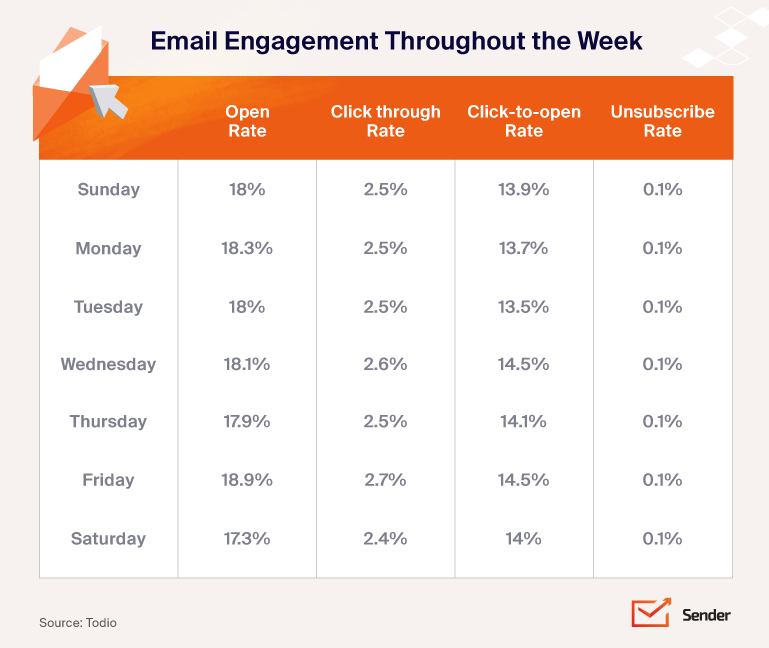
According to the data shared above, here are the best days of the week for scheduled email campaigns:
- Friday: Friday registers the highest open, click-to-open, and click-through rates.
- Wednesday: Wednesday is the second-best day to email if you consider all three metrics overall.
- Monday: Monday registers the highest open rates after Friday but has slightly lower click-to-open rates than Wednesday, so it comes at a close third.
You’ve got the right days of the week, now find out the best time to send emails in 2024 (by email type)
Email Broadcasts: Wrap Up
Broadcast emails are a great way to keep users hooked and informed. You can use them to automate a sales email, promotional email, newsletter, or announcement. Just remember to:
- Keep the emails short with a compelling CTA to increase readers’ interest;
- Schedule at appropriate times based on audience time zones for higher engagement;
- Mix and match different formats to find the best way to leverage broadcast messaging for your business;
- Sync them with an autoresponder campaign for the maximum impact.
Author bio
Vesta Oldenburg is a content writer specializing in email marketing strategies. In her daily work, creativity intertwines with a strategic mindset to create content that captivates its readers.
